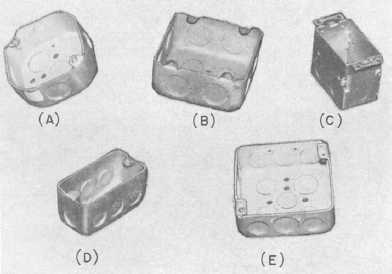grounded system. They provide a means of holding the
conduit in position, space for mounting such devices as
switches and receptacles, protection for these devices,
and space for making splices and connections. Outlet
boxes used in Navy construction are usually made of
galvanized steel; however, nonmetallic boxes, such as
rigid plastic compounds, are being used for approved
installation. Boxes are either round, octagonal, square,
or rectangular in shape. Commonly used outlet boxes
are shown in figure 9-17.
An outlet box is simply a metal container, set flush
or nearly flush with the wall, floor, or ceiling, into
which the outlet receptacle or switch will be inserted
and fastened. Figure 9-17, view A, is a 4-in. octagon
box used for ceiling outlets. This box is made with 1/2-
or 3/4-in. KNOCKOUTS—indentations that can be
knocked out to make holes for the admission of
conductors and connectors. Figure 9-17, view B, shows
a 4 11/16-in. square box used for heavy duty, such as
for a range or dryer receptacle. It is made with
knockouts up to 1 in. in diameter. Figure 9-17, view C,
is a sectional or GEM BOX used for switches or
receptacles. By loosening a screw, you can remove the
side panel on the gem box so that two or more boxes
can be GANGED (combined) to install more than one
switch or receptacle at a location. Figure 9-17, view D,
is a UTILITY BOX, called a handy box, made with 1/2-
or 3/4-in. knockouts and used principally for open-type
work. Figure 9-17, view E, is a 4-in. square box with
1/2- or 3/4-in. knockouts, used quite often for switch or
receptacle installation. It is equipped with plastic rings
having flanges of various depths so that the box may be
set in plaster walls of various thicknesses.
Besides the boxes shown, there are special boxes
for switches when more than two switches at one
location are required. These are called CONDUIT
GANG BOXES, and they are made to accommodate
three, four, five, or six switches. Each size box has a
cover to fit.
The NEC
requires that outlet boxes be 1 1/2 in.
deep except when the use of a box of this depth will
result in injury to the building structure or is
impractical, in which case a box not less than 1/2 in.
deep may be used. For switch boxes, the 2 1/2-in. depth
is the most widely
73.15
Figure 9-17.-Types of outlet boxes.
9-13

